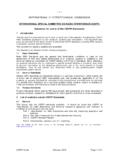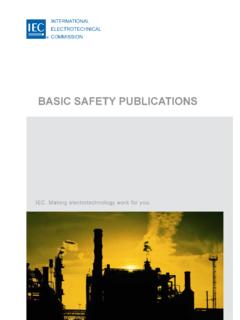Transcription of Factory of the future - Welcome to the IEC
1 White Paper . Factory of the future Executive summary By tradition, manufacturing has been thought of automation. Over time, the food industry as to be a process that turns raw materials into well as pharmaceutical and other manufacturing physical products, and the Factory , in managing companies has also heavily relied on automation to fragmented communications protocols and produce more and at lower cost. This often results automation practices, is the structure where in higher end quality and reliability throughout the manufacturing happens.
2 Today, drivers such assembly chain to the advantage of the consumer. as technology, sustainability, optimization and The ultimate goal of the Factory of the future is the need to meet customer demands have once to interconnect every step of the manufacturing again encouraged the transformation of the process. Factories are organizing an unprecedented manufacturing industry, to become adaptive, fully technical integration of systems across domains, connected and even cognizant of its own power hierarchy, geographic boundaries, value chains quality.
3 This transformation is characterized by the and life cycle phases. This integration will only be globalization of value chains in organizations, with a success if the technology is supported by global the goal of increasing competitive advantages, consensus-based standards. Internet of Things creating more value add-ons and reducing costs (IoT) standards in particular will facilitate industrial through comprehensive sourcing. In support of automation, and many initiatives (too many to list this notion, one of the most significant trends in here) in the IoT standardization arena are currently manufacturing is the makeover from industrial underway.
4 To keep up with the rapid pace of Ethernet and industrial wireless communications advancing technology, manufacturers will also need to that of improved information technology (IT). to invest in both digital technologies and highly solutions involving the union of conventional skilled technical talent to reap the benefits offered automation with cyber-physical systems combining by the fast-paced factories. Worker safety and communications, information and communication data security are other important matters needing technology (ICT), data and physical elements and constantly to be addressed.
5 The ability to connect devices to one another. This IT transformation, which shifts the manufacturing So what will the Factory of the future look like and process from a patchwork of isolated silos to a how will it be put into action? This White Paper will nimble, seamless and fully integrated system of assess the potential worldwide needs, benefits, systems (SoS) matching end user requirements in concepts and preconditions for the Factory of the the manufacturing process, can be described as future , while identifying the business trends in Factory of the future (FoF).
6 Related technologies as well as looking at market readiness. The advantages of having automated systems have been quickly recognized by industry. Due to the Section 2 leads with the current manufacturing rapid evolution of IT in the second part of the 20th environment and its evolution across the centuries. century, engineers are able to create increasingly The benefits of having multiple, bi-directional complex control systems and integrate the Factory value chains are essential as well as supporting floor. The automotive industry, for instance, has information optimization across organizational been transformed radically by the development boundaries.
7 3. Executive summary Section 3 provides a brief background on manufacturing paradigms throughout history Acknowledgments and examines various regional concepts of This White Paper has been prepared by the new manufacturing initiatives, their underlying Factory of the future project team in the IEC Market technologies and preconditions and their impact Strategy Board (MSB), with a major contribution on different facets of the manufacturing area. being furnished by the project partner, the Section 4 examines the driving technologies for Fraunhofer Institute for Manufacturing Engineering implementation of Factory of the future concepts.
8 And Automation IPA. The project team met on Technical challenges and preconditions many 3 occasions: October 2014 in Cleveland, January things are promised early, but take time to become 2015 in Stuttgart and April 2015 in Pittsburgh, and existent are also underscored as well as how to held a number of on-line conference calls. The enable the necessary technologies. project team includes: Section 5 balances the adoption of new Mr. Daryll Fogal, Project Leader, IEC MSB. technologies with the prerequisites for market Member, Tyco International readiness.
9 Ms. Ursula Rauschecker, Project Partner Leader, Fraunhofer IPA. Section 6 envisages the future landscape, with consideration being given to enabling technologies Mr. Peter Lanctot, Project Administrator, IEC. as well as some of the specific challenges involved. Mr. Andreas Bildstein, Fraunhofer IPA. Section 7 concludes with a list of recommendations Mr. Mark Burhop, Siemens for addressing the requirements related to data, Dr. Arquimedes Canedo, Siemens people, technology and standards for factories of Mr. Kai Cui, Haier Group the future .
10 Mr. Teruaki Ito, Mitsubishi Electric Mr. Benoit Jacquemin, Schneider Electric Mr. Kevin J. Lippert, Eaton Corporation Mr. Andy Macaleer, SAP. Mr. Alec McMillan, Rockwell Automation Dr. Youichi Nonaka, Hitachi Mr. Noritaka Okuda, Mitsubishi Electric Mr. Ken Sambu, Mitsubishi Electric Ms. Veronika Schmid-Lutz, SAP. Mr. Haibo Shi, Shenyang Institute of Automation (CN). Dr. Kazuhiko Tsutsumi, IEC MSB Member, Mitsubishi Electric Mr. Chris G. Walker, Eaton Corporation Mr. Chunxi Wang, Instrumentation Technology and Economy Institute (CN).










